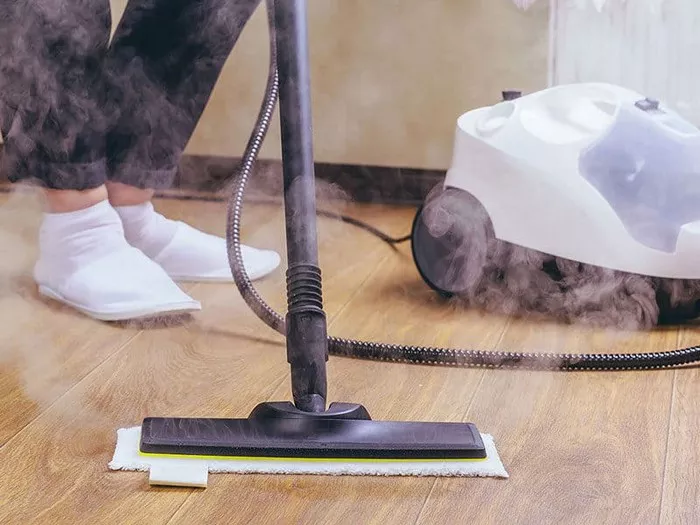Maintaining the beauty of wood floors is a priority for many homeowners. They provide warmth and elegance, but they also require specific care. One common question arises: is steam cleaning bad for wood floors? This article explores the effects of steam cleaning on wood flooring, including potential risks and best practices for safe cleaning.
Understanding Wood Floors
Types of Wood Flooring
Wood flooring can be categorized into two main types: solid wood and engineered wood. Solid wood is made from a single piece of hardwood, while engineered wood consists of layers of plywood topped with a hardwood veneer. Each type has unique characteristics and care requirements.
Benefits of Wood Floors
Wood floors offer numerous benefits. They are durable, aesthetically pleasing, and can increase a home’s value. Additionally, wood floors are relatively easy to clean and maintain when cared for properly.
The Basics of Steam Cleaning
What is Steam Cleaning?
Steam cleaning uses high-temperature steam to clean surfaces. This method effectively lifts dirt, grime, and allergens, making it popular for various materials, including carpets and upholstery. However, the high heat and moisture it produces can impact other surfaces differently.
How Does Steam Cleaning Work?
A steam cleaner heats water to create steam. The steam is then released onto the surface, loosening dirt and debris. As the steam condenses, it captures the grime, which can be wiped away easily.
Potential Risks of Steam Cleaning on Wood Floors
Moisture Damage
Wood is a natural material that can absorb moisture. When steam is applied to wood floors, it can seep into seams and gaps. Excess moisture can lead to warping, buckling, or splitting over time. This is particularly concerning for solid wood floors, which are more susceptible to damage than engineered wood.
Finish Damage
Most wood floors have a protective finish that helps repel water and dirt. The heat and moisture from steam cleaning can compromise this finish. It may dull the surface, leaving it vulnerable to scratches and stains.
Mold Growth
If wood floors do not dry completely after steam cleaning, the residual moisture can promote mold growth. Mold thrives in damp environments, and wood provides an ideal surface for it to develop.
When Steam Cleaning Might Be Acceptable
Engineered Wood Floors
Engineered wood floors can handle moisture better than solid wood. If you choose to steam clean, ensure that the flooring is specifically rated for moisture. However, even with engineered wood, it’s important to use steam cleaning sparingly.
Spot Cleaning
Using steam cleaning for spot cleaning can be effective if done carefully. Focus on small areas with visible stains or spills, and avoid saturating the wood with moisture.
Best Practices for Steam Cleaning Wood Floors
Use the Right Equipment
If you decide to steam clean, use a steam cleaner designed for wood floors. These models typically have adjustable settings to control steam output and minimize moisture exposure.
Keep Distance
When using a steam cleaner, hold the nozzle a few inches above the floor. This distance reduces the amount of steam applied at one time and prevents excess moisture from settling on the wood.
Limit Steam Exposure
Limit the time the steam cleaner is in contact with the wood floor. Quickly move the cleaner in a continuous motion to avoid over-saturating any one area.
Alternatives to Steam Cleaning
Dry Mopping
Dry mopping is an excellent alternative to steam cleaning. Using a microfiber mop can effectively capture dust and dirt without introducing moisture. Regular dry mopping helps maintain the floor’s appearance.
Damp Mopping
If deeper cleaning is needed, consider damp mopping with a specially formulated wood floor cleaner. Use a slightly damp mop rather than soaking the floor. This method is less likely to damage the wood than steam cleaning.
Professional Cleaning
Hiring a professional cleaner can be beneficial for maintaining wood floors. They have the right tools and techniques to clean without causing damage. Professional cleaning services often use methods that are safer for wood.
see also: Can You Use a Steam Cleaner for Ironing?
Maintaining Wood Floors
Regular Cleaning Routine
Establishing a regular cleaning routine is key to preserving wood floors. Vacuum or dry mop weekly to prevent dirt buildup. A clean floor is less likely to require heavy cleaning methods like steam cleaning.
Avoid Harsh Chemicals
When cleaning wood floors, avoid using harsh chemicals or abrasive cleaners. They can damage the finish and overall appearance of the wood. Stick to products specifically designed for wood flooring.
Monitor Humidity Levels
Maintaining proper humidity levels in your home is crucial for wood floors. High humidity can cause wood to swell, while low humidity can lead to shrinking. Aim for a balanced humidity level of around 30-50%.
Conclusion
In conclusion, while steam cleaning can effectively clean various surfaces, it poses risks to wood floors. The potential for moisture damage, finish deterioration, and mold growth makes steam cleaning a less than ideal choice. If you have wood floors, consider alternatives like dry or damp mopping.
If steam cleaning is necessary, ensure you use the right equipment and techniques to minimize risks. Ultimately, understanding your flooring type and adopting safe cleaning practices will help maintain the beauty and longevity of your wood floors.
Related topics:

